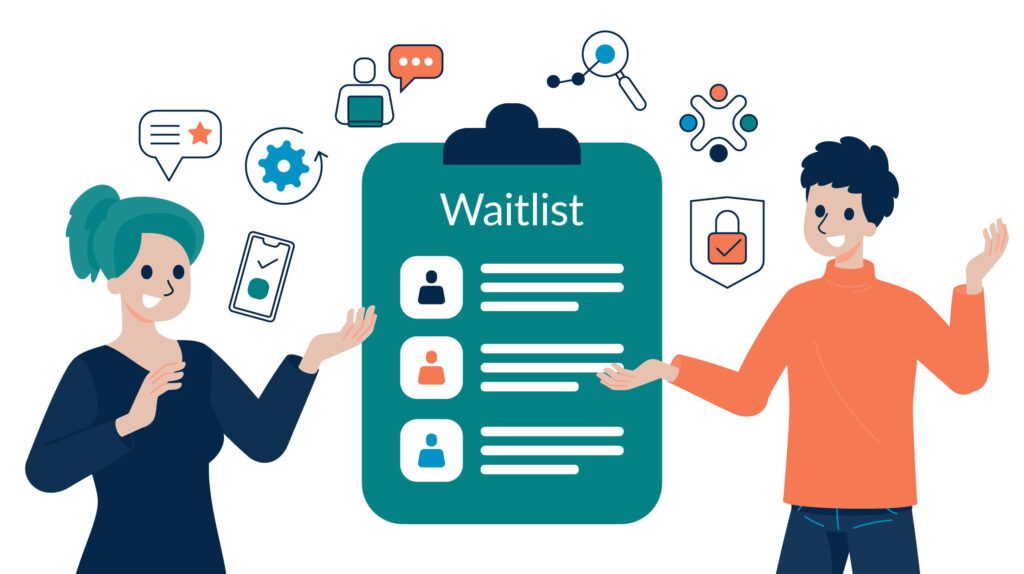Why your waitlist software should do more than waitlist management
- Effective waitlist management is not just about determining who is next; it is integral to optimizing overall service flow, encompassing customer experience, operational efficiency, and data-driven insights.
- Beyond creating and organizing customer waitlists, automated alerts, status updates, and simple insights into waitlist performance, a robust solution should enable accurate predictive wait time analytics, advanced reporting, task sequencing automation, customer feedback, enhanced security, and privacy features, inclusive accessibility options, mobile integration, and ongoing training support.
Effective waitlist management is critical in institutions such as the Departments of Motor Vehicles (DMV) and healthcare facilities, where customers often contend with extended waiting times for service. As defined by SourceForge, “Waitlist software provides organizations with the tools to collect and manage customer information to create waiting lists and customer databases.”With a waitlist management system, the DMV, for example, faced with limited resources, can allocate staff optimally through efficient waitlist management, contributing to the cost-effective operation of services. In addition, this practice creates fairness and transparency in service delivery, mitigating frustration and fostering an equitable experience.
Transparent communication regarding wait times is another key aspect of waitlist management, enhancing the overall customer experience by managing expectations and providing timely updates to those in line. In the healthcare sector, waitlist management supports appointment scheduling, helps prioritize patients based on urgency, and can reduce the incidence of no-shows through automated reminders.
However, it’s crucial to recognize that to truly address waitlist management challenges comprehensively, organizations should adopt more robust software solutions. These solutions go beyond basic waitlist functionality, robust waitlist management software can empower organizations not only to manage queues efficiently but also to derive valuable insights, integrate seamlessly with existing systems, and enhance overall operational efficiency. Thus, investing in advanced waitlist management solutions becomes imperative for organizations aiming to stay ahead in delivering optimal customer experiences.
Elevating service excellence with proactive waitlist management
Managing a waitlist extends beyond determining who is next in line; it is fundamental to optimizing overall service flow. For example, comprehensive solutions provide the capability to analyze customer traffic patterns. By identifying peak hours and understanding usage trends, businesses can make informed decisions to streamline operations. This analytical approach empowers the business to proactively alleviate waitlist challenges, providing a seamless and satisfying customer experience.

Embracing comprehensive software solutions also signifies a shift from reactive problem-solving to proactive, data-driven optimization. Rather than merely addressing issues as they arise, businesses equipped with robust software can anticipate and prevent bottlenecks, resulting in smoother service delivery.
Managing a waitlist is not merely a logistical exercise but an integral part of shaping a positive customer journey. Adopting robust software solutions transforms the waitlist management process from a reactive task to a proactive strategy. This shift enhances operational efficiency, improves the overall customer experience, and positions businesses to thrive in an environment where data-driven optimization is key.
Fundamental functions of waitlist software
The basics of waitlist software revolve around creating an efficient and user-friendly system for managing customer queues. Here are examples of some basic waitlist software features:
Customer waitlists: One of the primary functions of waitlist software is its ability to enable businesses to create, organize, and efficiently manage customer waitlists. This includes the seamless integration of in-person and remote options for customers to join the waitlist, providing flexibility and convenience in accessing services.
Automated alerts: An essential feature of waitlist software is its automated alert system, which plays a pivotal role in keeping customers informed about their status in the queue. Automated alerts are sent as customers’ turns approach or when the designated table or service becomes available. This reduces uncertainty and wait times and improves overall customer experience.
Status updates: Waitlist software provides real-time updates on wait times and status changes, allowing businesses to keep customers informed and manage their expectations effectively. This transparency fosters a sense of trust and satisfaction among patrons.
Simple waitlist insights: Besides its practical functionalities, waitlist software offers simple insights into waitlist performance. Businesses can access information on average wait times, enabling them to assess and enhance their operational efficiency. However, to propel the business to new heights and offer an exceptional experience for customers, embracing a waitlist system with advanced, robust features is the key to success.

Advanced waitlist software features
Here are examples of some advanced waitlist software features:
Accurate predictive wait time analytics: Customers appreciate transparency, especially regarding wait times. A cutting-edge waitlist software goes beyond simple notifications and provides predictive analytics for wait times. The software can estimate how long a customer will likely wait by analyzing historical data, traffic patterns, and current demand. This manages customer expectations and enables businesses to proactively allocate resources and adjust staffing levels based on anticipated demand.
Advanced reporting: Understanding the efficiency of your waitlist system is crucial for continuous improvement. For instance, WaitWell incorporates queue performance metrics into its software, monitoring vital indicators like average wait time, service speed, peak hours, staff performance, customer reviews, and more. These metrics offer actionable insights into operational bottlenecks and areas where improvements are needed. By monitoring the performance of your waitlist, you can refine your processes to optimize your business’s overall efficiency and success.
Task sequencing automation: By incorporating task automation features into a queue management solution, businesses can eliminate bottlenecks, reduce wait times, and enhance productivity. Workflow automation ensures that tasks are seamlessly assigned and completed, minimizing manual intervention and human error. This optimizes resource allocation and improves the customer experience by providing a smoother and faster service. In a world where time is a precious commodity, a queue management solution with workflow automation becomes a strategic asset, enabling businesses to deliver prompt and reliable services while maintaining operational agility.
Enhanced security and privacy features: As businesses handle sensitive customer data through waitlist software, prioritizing security and privacy is non-negotiable. Advanced waitlist solutions incorporate robust security measures, such as data encryption and secure access controls, to safeguard customer information. By ensuring the privacy and security of customer data, businesses build trust and credibility, which are essential components of a positive customer experience.
Inclusive accessibility features: A forward-thinking waitlist software should incorporate accessibility features to cater to diverse customer needs. This includes text-to-speech functionality, color-contrast options, and compatibility with kiosks and other assistive technologies. By embracing inclusivity in your waitlist software, you demonstrate a commitment to serving all customers, regardless of their requirements.
Mobile friendliness: In an era dominated by smartphones, providing a mobile-friendly experience is paramount. A comprehensive waitlist solution should allow customers to join the waitlist remotely, receive updates on their position, and engage with interactive features—all from the convenience of their mobile devices. This enhances customer convenience and reinforces your brand’s commitment to staying technologically current.
Ongoing training support: Implementing a new waitlist software solution may require staff training and ongoing support. A comprehensive solution includes user-friendly interfaces, access to training resources, and responsive customer support. This ensures that your team can maximize the benefits of the software and quickly address any issues that may arise. Ongoing training and support contribute to a smooth implementation process and foster a positive relationship between your business and the software provider.
Ongoing training support: Implementing a new waitlist software solution may require staff training and ongoing support. A comprehensive solution includes user-friendly interfaces, access to training resources, and responsive customer support. This ensures that your team can maximize the benefits of the software and quickly address any issues that may arise. Ongoing training and support contribute to a smooth implementation process and foster a positive relationship between your business and the software provider.
Elevating service efficiency with WaitWell’s waitlist solution
The WaitWell queue management system is a top choice for managing waitlists as it efficiently organizes and handles customer queues. The system has emerged as a preferred choice across various industries, including healthcare, government, DMVs, retail locations, travel and hospitality, and higher education.
At its core, WaitWell is engineered to ensure a seamless and efficient workflow, responding to the evolving demands of businesses aiming to elevate their customer service experiences. One of its standout features lies in its simplicity. Staff seamlessly ease into its use and customers often praise the flexible check-in feature, whether they are physically present on-site or prefer the flexibility of remote check-ins on their mobile. This shows WaitWell’s ability to cater to diverse customer preferences and underscores its commitment to delivering a flexible and adaptable waitlist management process.
WaitWell has also been consistently praised for minimizing wait times. Its intuitive design enables the efficient organization and prioritization of customers, resulting in a notable reduction in overall wait times. This contributes to heightened customer satisfaction and enhances operational efficiency for businesses leveraging WaitWell.
In addition to its core functionalities, WaitWell stands out with robust reporting and analytics capabilities. With a comprehensive suite of 25+ reports and analytics tools, businesses gain valuable insights into waitlist performance, workforce productivity, customer behavior, and operational trends. This wealth of data empowers businesses to make informed decisions, refine their strategies, and continuously enhance the customer experience. WaitWell’s dedication to providing a solution and a tool for data-driven optimization sets it apart as an invaluable asset for businesses seeking to stay ahead in the competitive customer service landscape.
WaitWell transcends the conventional role of a waitlist management tool; it is a dynamic solution that transforms the customer waiting experience. Its commitment to simplicity, flexibility, and efficiency positions it as a valuable asset for businesses seeking to elevate their customer service standards and optimize overall operations.







